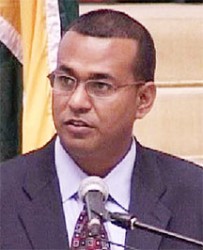In the week that Natural Resources and the Environment Minister Robert Persaud signed the Minamata Convention on Mercury in Japan this newspaper monitored two mercury-related stories in sections of the international media that had to do with the use and effects of the toxic metal.
The first story was about a 12-year-old Tanzanian boy who has been using his bare hands to mix mercury with ground-up ore to create a mercury-gold amalgam after which he burns off the mercury to retrieve the raw gold. Ibrahim (the boy’s name) has worked in small-scale gold mines since he was nine.
The International Labour Organisation (ILO) estimates indicate that up to one million children work in mining globally while Human Rights Watch has also documented children’s exposure to mercury in mining communities in Mali, Ghana and Papua New Guinea.

Robert Persaud
The second story has to do with large numbers of illegal miners in Indonesia whose high-pressure hoses blast tonnes of sand out of the ground daily in open pits before using mercury to separate the gold from the sand.
Under the Minamata Convention, governments are required to act to eliminate harmful mercury use, promote mercury-free gold processing alternatives, and protect children from the harmful effects of mercury.
While mercury is commonly used in gold-mining operations across Asia, Africa and Latin America as a cheap and easy way to extract gold from ore, the returns from the precious metal mean that disproportionate attention is paid to the cost to human health and to the environment.
Last week in Georgetown, Cabinet Secretary Dr Roger Luncheon made the point about the high cost associated with the application of the alternative technology in the gold-mining industry. “It should be pointed out,” he told a post-Cabinet press briefing, “that alternatives to mercury in the gold-mining that is done in Guyana are not cheap. The technology is a substantial technology and not readily accessible by the thousands of small miners.”
While Persaud had gone to Japan to sign on to the convention that seems set to bring an end to mercury use in the local gold industry, Luncheon’s pronouncement was essentially a gesture designed to buy time.
Official reports indicate that during his visit to Japan, Persaud engaged in quite a bit of diplomatic legwork, lobbying both the Japanese government and the United Nations Environment Programme (UNEP) and securing commitments from both to support Guyana’s phased approach to the removal of mercury. Guyana’s pursuit of financial support reportedly takes account of the need to undertake environmental education and build monitoring capacity at mining sites.
Both the Guyana Geology and Mines Commission (GGMC) and the Guyana Gold and Diamond Miners Association (GGDMA) have, for some time, been doing exploratory work aimed at introducing non-mercury gold recovery methods to the sector. At least one local firm has told Stabroek Business that it is investing in technology which, to some extent, might be shared by small miners, though Luncheon pointed out that ideally, it would be necessary for “financing to be provided to countries like Guyana where the issue of alternatives to the use of mercury essentially has dominant financial implications.”
Those “dominant financial implications” have to do with the repositioning of gold as the country’s principal foreign exchange earner and the fear that higher operating costs associated with more expensive gold-recovery methods could negatively affect the industry.
Up until early this year, continually climbing prices had caused gold to emerge as the centrepiece of a Guyana economy in which sugar, once the country’s main money-earner, had fallen into a condition of near complete collapse. Much earlier the same fate had befallen bauxite industry. Indeed, encouraged by spiralling gold prices, local miners have, in the last three years, ramped up production to more than 300,000 ounces annually, a figure that does not take account of what is widely believed to be high levels of smuggling. Production estimates for this year have reached close to 500,000 ounces. So profitable has been the sector that the slippage in price has not deterred a continued rise of investment.
Even before the eventuality of Minamata, however, it was clear that health and environmental issues associated with the use of mercury were beginning to catch up with the mining sector. More than three years ago a senior official of the GGMDA told this newspaper that miners were not “wedded to mercury” though the reality is – as Luncheon made clear recently – that there is as yet no clear alternative on the horizon.
By signing on to the Minamata Convention the Government of Guyana has acknowledged that its particular difficulties notwithstanding, the world will not wait on the local gold-mining sector forever. More than that, to resist the intensifying lobby to rid the mining sector of mercury, Guyana will have to risk its own internationally established environmental credentials.
Luncheon has said that “between 2013 and 2022” Guyana will be “phasing in restrictions against importation and against the use of mercury in gold mining,” though mining sources have told this newspaper that the government’s lack of effective monitoring mechanisms in the gold-mining sector will mean that – for a while at least – small miners for whom alternative technology is out of reach, will take the risk of smuggling in the controversial chemical. “The thing about mercury,” one miner told Stabroek Business on Monday “is that only modest quantities are required in mining operations. Even if a ban is imposed tomorrow it is more than likely that mercury will be acquired and used in the sector.”
Interestingly, while the announcement by Luncheon that Guyana is giving itself up to 2022 before it moves to ban the use of mercury in the mining sector was attended by a pointed comment on the cost of alternatives, the Cabinet Secretary stopped short of making any pronouncement that might cause miners to think that government would, hereafter, be reading an incremental riot act on mercury users. What is probably more likely to happen – at least in the short term – given the weak official oversight mechanisms is that high-profile pursuit of mercury-free initiatives like the Correia Mining Company’s initiative announced two weeks ago and the various other technology trials underway in the industry will take place side by side with the ongoing use of mercury by the vast majority of small miners who may well be hoping to make their fortunes in the sector long before the prohibition kicks in.








